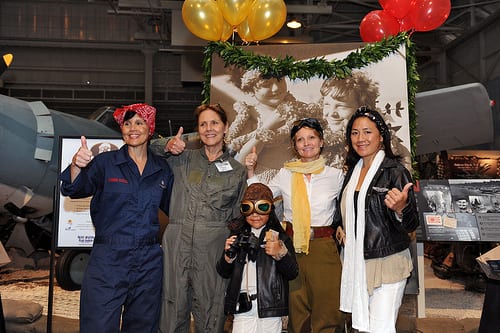HONOLULU, Hawaii — More than 700 people celebrated the famous aviatrix Amelia Earhart’s 116th birthday at Pacific Aviation Museum Pearl Harbor,Wednesday, July 24.
 Families with at least one person in costume were invited to visit the museum free, view the museum’s “Amelia Earhart in Hawaii” photo exhibit, enjoy the festivities with cake and refreshments, and meet “Amelia” and members of The Aloha Chapter of the Ninety-Nines International Organization of Women Pilots, of which Earhart was the first president.
Families with at least one person in costume were invited to visit the museum free, view the museum’s “Amelia Earhart in Hawaii” photo exhibit, enjoy the festivities with cake and refreshments, and meet “Amelia” and members of The Aloha Chapter of the Ninety-Nines International Organization of Women Pilots, of which Earhart was the first president.
The winners of the “Dress Like Amelia” costume contest were: Wynter Marlow, first place; Alana Uehara, second place; Sara Lemstrom, third place.
“This is a family event that brings the pioneers and heroes who have paved the way for women in aviation to our guests. We’re honored to have Hawaii’s women aviators participate and we’re honored to celebrate Amelia Earhart and her accomplishments,” said Museum Executive Director Kenneth DeHoff. “She has a very special connection with us here at Pacific Aviation Museum Pearl Harbor.”
 Before her disappearance, Earhart set numerous aviation records, including being the first person to fly solo across both the Pacific and Atlantic Oceans.
Before her disappearance, Earhart set numerous aviation records, including being the first person to fly solo across both the Pacific and Atlantic Oceans.
Born July 24, 1897, she has a special connection with the museum as she ground-looped her plane on takeoff on the historic Ford Island Runway, preventing her initial round-the-world flight attempt. Seventy-six years ago, Earhart took a leave of absence from her Purdue University job, hopped in her Purdue-funded “Flying Laboratory” and flew around the globe. Then she disappeared.
The latest 2012 expedition to recover her plane by The International Group for Historic Aircraft Recovery (TIGHAR) claims to yield new sonar images that reveal what appears to be the wing or fuselage of an aircraft matching the dimensions of Earhart’s Lockheed Electra, underwater off the coast of remote Nikumaroro Island in the southwestern Pacific Ocean. The tiny atoll is believed by some to be her final resting place.
Pacific Aviation Museum Pearl Harbor is a 501(c) 3 nonprofit organization. It is open 9 am to 5 pm daily, on Historic Ford Island, Pearl Harbor, Oahu, Honolulu, Hawaii.

Pam- i don’t see an email address for you. I am at [email protected]. My husband is Susie’s Grandson. Hope to hear from you soon!
Kristan
My husband is the great-grandson of Tak Wing Tom. I am hoping that you (Pam Carleton) might get in contact with us because you all are related. I am on FB. Thanks!
Hi Kristan,
Great hearing from more relatives!! Email me!
Pam
My great uncle was Tak Gunn Tom, better known and famous as Aviator Tom Gunn. Not many people may have heard of him, but I would like more people to recognize the significance he played in aviation history, and hope that the General Aviation News can help spread the word about him. He accomplished many things in aviation, and a hundred years ago, on July 13, 1913, he introduced passenger flight to Hawaii.
One of ten siblings (he was a brother of my maternal grandmother), he was born on October 13, 1890 in San Francisco, California but his family moved to Oakland after the great San Francisco earthquake. He built and designed his own airplanes, with his older brother, Tak Wing Tom, as his assistant and chief mechanic. He attended flight school in New York and the Los Angeles area and was the first Chinese-American aviator in the U.S. and was certified by the Aero Club of America and given pilot’s license #131 on June 19, 1912, at 21 years of age.
An aviation daredevil, stunt pilot and barnstormer, he represented China in the 1910 International Aviation Meet in Los Angeles, and was dubbed the “Wright of China.” When revolution erupted, Tom Gunn was contacted by Sun Yat-Sen to popularize aviation. His expertise so impressed Sun Yat-Sen that the revolutionary leader placed Tom Gunn in charge of China’s fledgling air force.
Tom Gunn went on to the Hawaiian Islands where he gave aerial demonstrations at Schofield Barracks on July 5 to July 8, 1913, where he demonstrated the first flying boat seen there. Only July 13, 1913, he took up the first passenger in Hawaii. In two years Tom Gunn made more than 800 flights and carried more than 300 passengers in the Pacific region, including the Hawaiian Islands. He went to the neighboring islands and the Philippines to inaugurate air-mail services before settling in China to fly for Sun Yat-Sen. He died in a mysterious rickshaw accident in 1925, only 35 years old, possibly the target of assassination.
I am honored to be related to such a free spirit. During that time in the early 1900’s, he probably had to overcome many obstacles and barriers, but he was so ambitious, very brave and adventurous, and very determined to accomplish his dream to fly, and he made aviation history by doing so.
On July 13, 2013, exactly on the 100th anniversary of his inaugural flight, introducing passenger flight in Hawaii, the Pacific Aviation Museum at Pearl Harbor opened their new “Pacific Aviation Pioneers Exhibit” and gave my great uncle, Aviator Tom Gunn, the honor of being the first inductee in this exhibit. This exhibit is in the remodeled Doolittle Gallery in Hanger 37. During the year, a rotating series of exhibits will highlight the personalities who created aviation history in the Pacific region. The exhibit on my great uncle, Aviator Tom Gunn, may be there probably until mid-November or December.